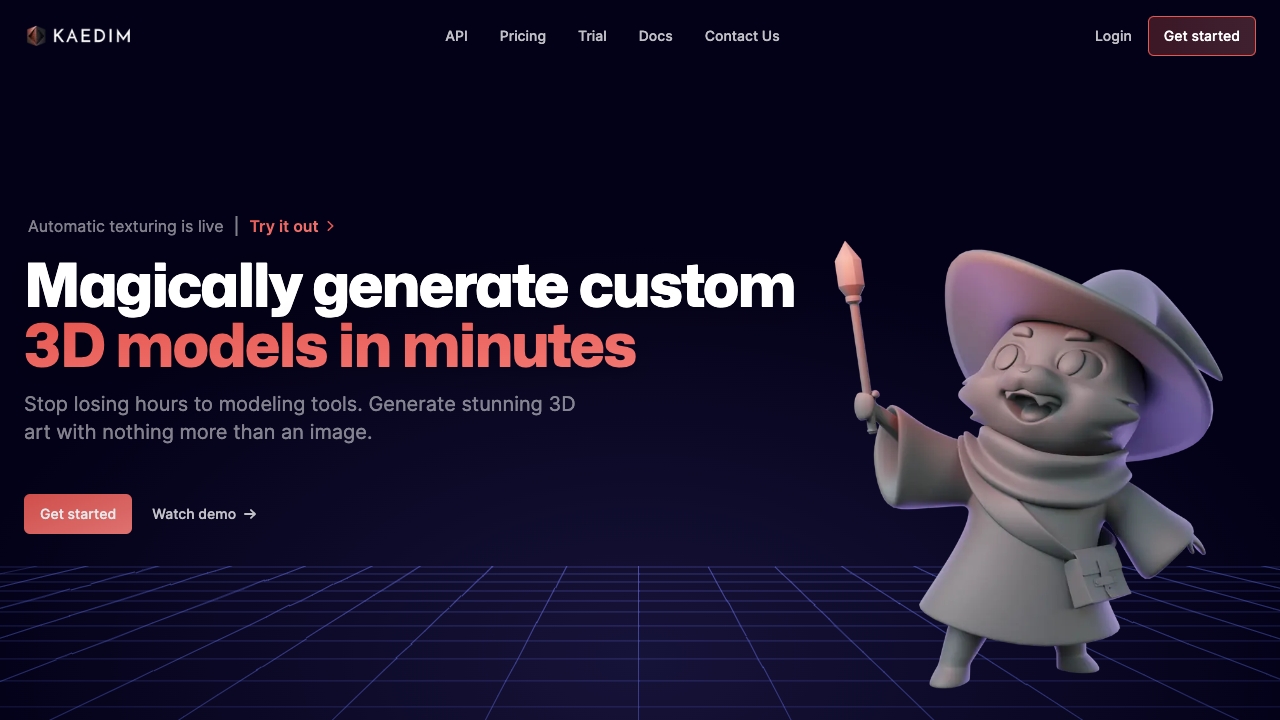- Home
- AI 3D Model Generator
- Kaedim

Kaedim
Open Website-
Tool Introduction:Kaedim: Convert 2D to game‑ready 3D fast—AI + artists, on‑demand at scale.
-
Inclusion Date:Nov 05, 2025
-
Social Media & Email:
Tool Information
What is Kaedim AI
Kaedim AI is an AI-powered art outsourcing platform that converts 2D images into high-quality 3D models with remarkable speed. By combining machine learning with experienced modeling experts, it delivers game-ready, production-quality assets through an on-demand, scalable workflow. Upload concept art or product photos and receive tailored 3D models that match your specifications, helping teams reduce iteration time and ship faster. Built for studios and startups, Kaedim streamlines 3D content creation for games, ecommerce, AR/VR, and product visualization while preserving creative control and consistency.
Main Features of Kaedim AI
- 2D-to-3D conversion: Automatically generate 3D models from images or concept art to accelerate asset creation.
- Human-in-the-loop quality control: Modeling experts refine AI outputs to meet production standards and artistic direction.
- Game-ready delivery: Receive optimized assets suitable for integration into common pipelines and engines.
- On-demand scalability: A ready-to-scale platform that supports bursts in production without hiring overhead.
- Collaborative reviews: Share feedback, request adjustments, and maintain alignment on style and specs.
- Consistent style and specs: Define guidelines so assets match your level of detail, dimensions, and look.
- Faster turnaround: Shorten iteration cycles to move from concept to deployment more quickly.
Who Can Use Kaedim AI
Kaedim AI suits game developers, ecommerce teams, and product designers who need high-quality assets fast. It helps studios build environments and props, retailers create immersive product visuals, AR/VR teams prototype interactive content, and agencies deliver 3D campaigns at scale. Startups benefit from reduced time-to-market, while larger teams use it to handle peak demand without expanding in-house capacity.
How to Use Kaedim AI
- Create a project and outline goals, style, and any technical requirements.
- Upload 2D references such as sketches, turnarounds, or product photos.
- Specify asset details: target use (game, ecommerce, AR/VR), level of detail, and file preferences.
- AI generates an initial 3D model, which is then refined by experts for quality and accuracy.
- Review the preview, add comments, and request revisions if needed.
- Approve the result and download the production-ready 3D asset for your pipeline.
Kaedim AI Use Cases
Studios convert concept art into game-ready props and characters for faster level building. Ecommerce and retail teams turn product photos into interactive 3D product visuals for PDPs and AR try-on. Industrial and product designers build 3D prototypes from sketches to validate forms early. Marketing agencies deliver 3D campaign assets across channels, while AR/VR teams accelerate content creation for immersive experiences and digital twins.
Pros and Cons of Kaedim AI
Pros:
- Significantly reduces time from 2D concept to 3D model.
- Human-in-the-loop refinement ensures production-quality results.
- Scalable, on-demand capacity for spikes in asset needs.
- Consistent output aligned to style and technical specs.
- Streamlines collaboration and revision cycles.
Cons:
- Highly stylized or complex assets may require extra iterations.
- Results depend on clarity and completeness of 2D references.
- Turnaround and cost can vary with complexity and volume.
- Some bespoke workflows may still need in-house adjustments.
FAQs about Kaedim AI
-
What inputs does Kaedim AI need?
Provide clear 2D images or concept art, plus notes on style, scale, and target use to guide the model.
-
How fast are deliveries?
Timelines depend on asset complexity and volume, but the platform is designed to be much faster than traditional modeling.
-
What output formats are supported?
Assets are delivered in common 3D formats suitable for integration into standard pipelines and major engines.
-
Who owns the final assets?
Ownership terms are defined in the service agreement; clients typically receive rights to use approved deliverables.
-
Can it handle realistic and stylized art?
Yes, provide visual references and guidelines so the team can match your desired look and level of detail.





